Archive for the ‘Uncategorized’ Category
 Field Day – 200 QSOs with a Flashlight Battery
Field Day – 200 QSOs with a Flashlight Battery
Field Day was an experiment this year. I ran my operation for nine hours using a 5V 18650 battery. I made 200 QSOs before calling it quits.
I operated on the deck with an MTR 4-B designed by KD1JV. The antenna was an 88 foot doublet up about 45 feet. I used the ZM-2 tuner. For power I used the Powerfilm Lightsaver. This is a 5 watt roll-up solar panel that charges a 3.7V 18650 battery rated at 3.2 Ahr. The battery inside the Powerfilm product is commonly used in flashlights. The combination of the rig and the power supply is crucial.
The MTR rigs will operate from 6 to 12 volts. The Powerfilm puts out 5V to a USB socket. The secret ingredient required to bring the USB voltage up to the operating voltage of the rig is a Baofeng USB charging dongle. This device takes a 5V input and outputs 10.3 volts… perfect for the MTR transceiver. With this voltage the MTR puts out a little less than 3 watts.
The Powerfilm Lightsaver is designed to charge cell phones for hikers and campers. It weighs only about 5 oz. and rolls up into a tiny package. Any USB 5V cell phone charging battery could be used with the Baofeng dongle.
This year my whole station operated on 5V. I used a Samsung tablet for logging.
In New Hampshire it was cloudy for most of Field Day, but fortunately the amorphous solar panel provides some charging even when it’s cloudy. I’m guessing that after 9 hours of operating the battery was down to about half capacity. The beauty of this system is that one could operate indefinitely with moderate sunshine.
I’ve been experimenting with this setup during hikes and bike rides for the last couple of months with a view to using it for Field Day. This year’s emergency exercise proves that it is viable for an extended grid-down power outage.
 Early Spring on the Pemigewasset River
Early Spring on the Pemigewasset River
I took a bike ride for the first time this year. I rode along the Pemigewasset River and worked Wisconsin and Florida. It was a glorious day.
Starting out at Shaw Cove, the water is much higher than usual. Buds are just beginning to show. The trail is strewn with debris from spring flooding. Tree branches block parts of the trail, but I can ride around it all. I head north a bit more than a mile and stop under a huge pine tree.
I brought a half-wave end-fed for 20 meters. The wire is about 30 feet long. I tossed it over a pine branch and set up the KD1JV Mountain Topper. The view is spectacular.
I sit on the ground with the Mountain Topper in front of me.
I’m powering the rig with a Powerfilm LightSaver solar panel with built-in 18650 battery. I’m using a USB dongle to step up the voltage from 5v to 10V. It’s a perfect setup for the Mountain Topper which puts out about 3.5 watts with 10V. I can operate indefinitely as long as the sun is shining.
Right away I hear K0BXB from Wisconsin and call him. Martin gives me a 539. He is 559 to me. Soon I hear Bernie KB4JR in Florida calling CQ. He gives me a 559. He is running 500 watts and is strong to me. I tune down the band and hear Tom W2TMT from Florida calling CQ. Tom gives me a 559. He is a strong 599.
After operating for 20 minutes, I pack up for the ride back. Soon the black flies will be out and bike rides will be troublesome for a few weeks. I take one last snapshot of the sparkling river.
 The creator Eric Guth 4Z1UG of QSO Today Virtual Ham Expo comments on my last post.
The creator Eric Guth 4Z1UG of QSO Today Virtual Ham Expo comments on my last post.
Good afternoon everyone and I wanted to post a comment that Eric Guth 4Z1UG the creator of QSO Today Ham Radio Expo left on my blog that is reposted at AmateurRadio.com. Click HERE to visit the post and the many comments.
I wanted to repost Eric’s comment here as I find that those who read the blog sometimes do not go through and read the comments. I felt it important to let my blog readers read his comment he posted. He mentions Ron who in a comment identified as knowing Eric and who is a blind ham.
Below is Eric’s response:
I appreciate all of the messages above, even the angry one. Nobody feels as bad as me about what happened. All of this I explained in the messages that I have already sent out. I have re-learned my lessons.
Ron is a true friend. Like I did last August, I am building a presentation listing with links to the videos for blind hams. It will be up hopefully by Friday. They will find it easily with a screen reader on the QSO Today Virtual Ham Expo website home page: qsotodayhamexpo.com
The Expo will be in on-demand mode with all of the videos until April 16th, then I will put a link to my Vimeo library, so you can watch them forever, even on your Roku box.
Go to qsotoday.vfairs.com to enter the Expo. Just need your email address, no fancy ticket number.
Finally, if you don’t need that $10.00 back, I can sure use it to bring the next Expo in August. This operation is expensive to build and host. I love making it and hope to attend it myself, rather than staying in the kitchen, next time.
73,
Eric, 4Z1UG
There were some other comments about the content of the Expo, infomercials and content of the Expo presentations. Below was Eric’s response to this:
There are over 80 presentations, 20% of them given by Sponsors. Most were the hard work of individuals who put them up. Sponsorship revenue was helpful to start us out, ticket sales pay for the cost of all of the people and services it takes to make the expo. I hope that you will come back today to enjoy the presentations that are hardly infomercials, but the amazing work of our fellow hams.
 New Antenna: The Following Footprints Are of My CW Signals (2021-March-14 @ 04:00 to 04:20 UTC).
New Antenna: The Following Footprints Are of My CW Signals (2021-March-14 @ 04:00 to 04:20 UTC).
The following footprints are of my CW signals on 2021-March-14 at about 04:00 to 04:20 UTC.
Click on this image to see a larger version of this image:
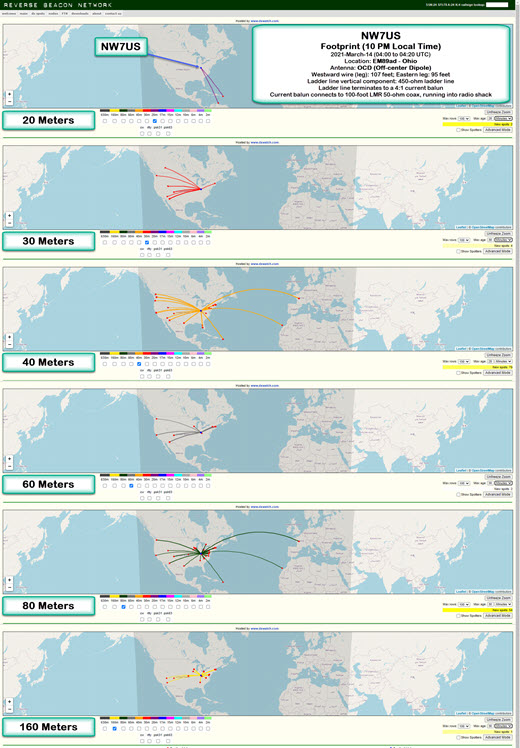
Location: EM89ad – Ohio
Antenna: OCD (Off-center Dipole)
Description of Antenna:
This is an off-center dipole, with the two legs running East-East-South (approximately 125 degrees of North), and West-West-North (about 306 degrees on the compass). The westward wire (leg) is approximately 107 feet in length, while the eastward leg is about 95 feet in length.
These legs (an off-center-fed dipole) is directly connected to about 90 feet of 450-ohm ladder line, which is hanging directly below, vertically, the feed point. The feed point is 50 feet above the ground.
The ladder line terminates (at the 12-feet-above-ground point) to a 4:1 current balun. This current balun then connects to a 100-foot LMR 50-ohm coax, which is running into the radio shack. It is connected via an antenna switch to my Icom IC-7610 transceiver. I am transmitting a 100-watt CW signal using an Icom IC-7610, in the following format:
TEST TEST TEST DE NW7US NW7US NW7US
The Reverse Beacon Network reports any spotting of this test transmission. The beta mapping interface, at http://beta.reversebeacon.net/main.php, then maps the resulting spots. To learn more about the RBN, visit http://beta.reversebeacon.net/index.php, or, http://reversebeacon.net/index.php.
I show the 20-, 30-, 40-, 60-, 80-, and 160-Meter band footprints.
I’ve been capturing these CW transmission spots, at different times of the day, today. I’ll get data from several days, at regular intervals, and create a overview of how the antenna appears to be working during this month and under these propagation conditions.
73 de NW7US dit dit
..
 Lemmings Over a Demographic Cliff?
Lemmings Over a Demographic Cliff?
Tradition and change are terrible bedfellows

It was an honor to have been invited to prepare what turned into a 2-article series in the ARRL’s National Contesting Journal on the aging demographics of hams who participate in the radio “sport” of contesting. These appeared in the July/August (Vol 48, No. 4) and Sept/Oct (Vol 48, No 5) issues. Dr. Scott Wright K0MD, Editor, asked me to assist with more fully analyzing the results of a survey conducted by the League office in Newington of their past and present subscriber list of NCJ recipients. I agreed but added some key data from four other sources. It particularly piqued my interest since amateur radio is a hobby. I spent part of my career studying the effects of sport participation and teaching undergraduate and graduate courses on the Sociology of Sports as a Professor. In future writing, I’ll compare amateur radio contesting to accepted definitions and elements of competitive sports.
In this Social Circuits column, there are several components. demography, the life course, vested interests and social capital. They are each valuable concepts to understand the Demographic Cliff facings U.S. contesting. But first, I’ll cover the additional data sources used in the two-part NCJ articles.
One data source was age distribution data from the U. S. Bureau of the Census (a source where I’ve lived, breathed, and used incessantly over the years). A second was the Time Use Survey from the Bureau of Labor Statistics. A third was from the ARRL’s membership files on age of member. A fourth was from the 2011 and 2013 surveys I conducted for the four states in the Delta Division as Assistant Director. Properly assembled, these four sources gave a much more illuminating picture of the challenges facing radio sport in the next decade. No, contesting is not likely to “die,” as great pessimists are likely to say, but it is clearly facing significant and perhaps substantial social change in order to remain a prominent ham radio niche.
I won’t repeat the two articles but I want to place some strategic emphasis on a few elements of the results and their implications. They have clear and almost compelling evidence for leadership in amateur radio to shape their programmatic actions to be more strategically efficient (that’s you, ARRL, among other groups). By that, I mean like we hams often chide the owner of a new HF screwdriver antenna on a vehicle: Yea, what you’re doing will work. But it could be done differently to be much a much more efficient antenna system! Don’t we want the ARRL and other groups to be more efficient with monies invested in those organizations?
The often-heard phrase of “only grey beards” inhabiting amateur radio these days is…both factual and a canard. The observed facts are that hams participating in several public activities do sport grey hair (and beards whether they still have hair on top!). These include those who say they participate in contests as well as appear at ham fests. But we simply do not have adequate data to make reliable inferences to all 750,000 or so hams holding licenses. We just don’t. And it’s causing all of the efforts by the League and other organizations to shoot into the dark more often than not. (The ARRL often says it’s conducted research on a topic but the previous CEO Howard Michel would not release the data to members who are even more savvy in terms of statistical survey analysis. Oy!) And we won’t. Until the ARRL or another entity supports the conduct of a professional caliber random sample survey design of the licensed amateur radio operators in the U.S.
But the “modest” data I presented in the NCJ articles do show the results in the following graphic on the demographic cliff. US is the Census Bureau’s age data for the U.S; ARRL is the League’s membership as a proxy for all hams (best available); and the NCJ is from the ARRL survey of past and present NCJ subscribers.
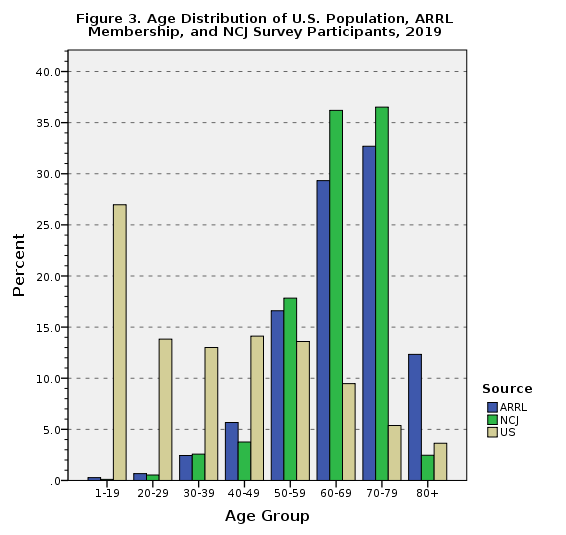
Hams, as indicated by the proxy of ARRL membership and in the NCJ past and present subscriber data, are sorely under-represented in the pre-50 age ranges. It’s not a close comparison either. More observantly, contest participants are even older in the aggregate than the League’s membership at large. This doesn’t mean that there are not contesters in the younger age groups, just that they are smaller in number. Why? There are some sound demographic reasons that have little to do with amateur radio itself. It’s important to understand non-amateur radio factors about the life course—the trajectory in which modern societies are organized around age-graded activities, positions and transitions. Sounds like gobbledygook? But so does many of the subjects we hams pride ourselves in to the uninitiated. Let’s get up to speed here.
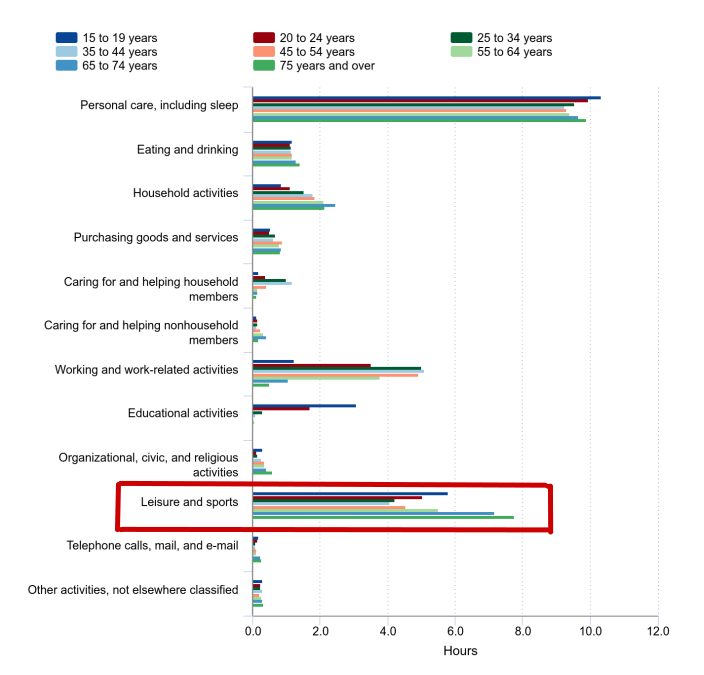
The American Time Use Survey, conducted regularly by the Bureau of Labor Statistics, is a very high quality data series. It is the standard for measuring how teenagers to adults in the U.S. spend their time. The chart above captures a picture in 2018 for time use, reflecting time spent per day on each activity group. The data are compared by age groups. I have put a red box around a key category. Where does amateur radio as a hobby fall there? In Leisure and sports (note the use of radio “sport” by contest participants).
What is the general age pattern? Leisure pursuits are highest during youth and young adulthood but dramatically taper off about ages 25-34 until age 55 and over. This hollowing out of leisure and sport time is a predictable outcome of competing and more important activities. It has little to do with amateur radio per se outside of it being a leisure activity. Note that personal care (including sleep!) follows a similar age-graded pattern. A converse age pattern of increasing time spent is observed for work and related activities, moving from less time while young toward peeks at mid-career and a tapering off later in the life cycle. On average, age is linked to more household activities and fewer educational ones. So the conventional wisdom about “losing” hams after they enter middle age is all about doing things to keep them focused on the hobby within the context of these competing obligations. But is that both reasonable and consistent with the long-celebrated Amateur Radio Code? Should we really want hams to forsake family or work for a hobby?
BALANCED…Radio is a hobby, never interfering with duties owed to family, job, school or community.
Let’s delve into another demographic pattern within the 6-8 hours per week spent on Leisure and Sports activities. From the TUS for everyone over age 15, here are sub-categories of leisure and sports activity. Of the weekly average of just over 5 hours, there is one clear time allocation: watching TV. It captures 60 percent (or about 3 hours) of all daily leisure/sport time. Socializing and communicating (ostensibly where amateur radio might fit in) is a pale second to television. (In the NCJ articles, I presented data from the Delta Division Surveys in 2011 and 2013 about time spent on the air per week.)
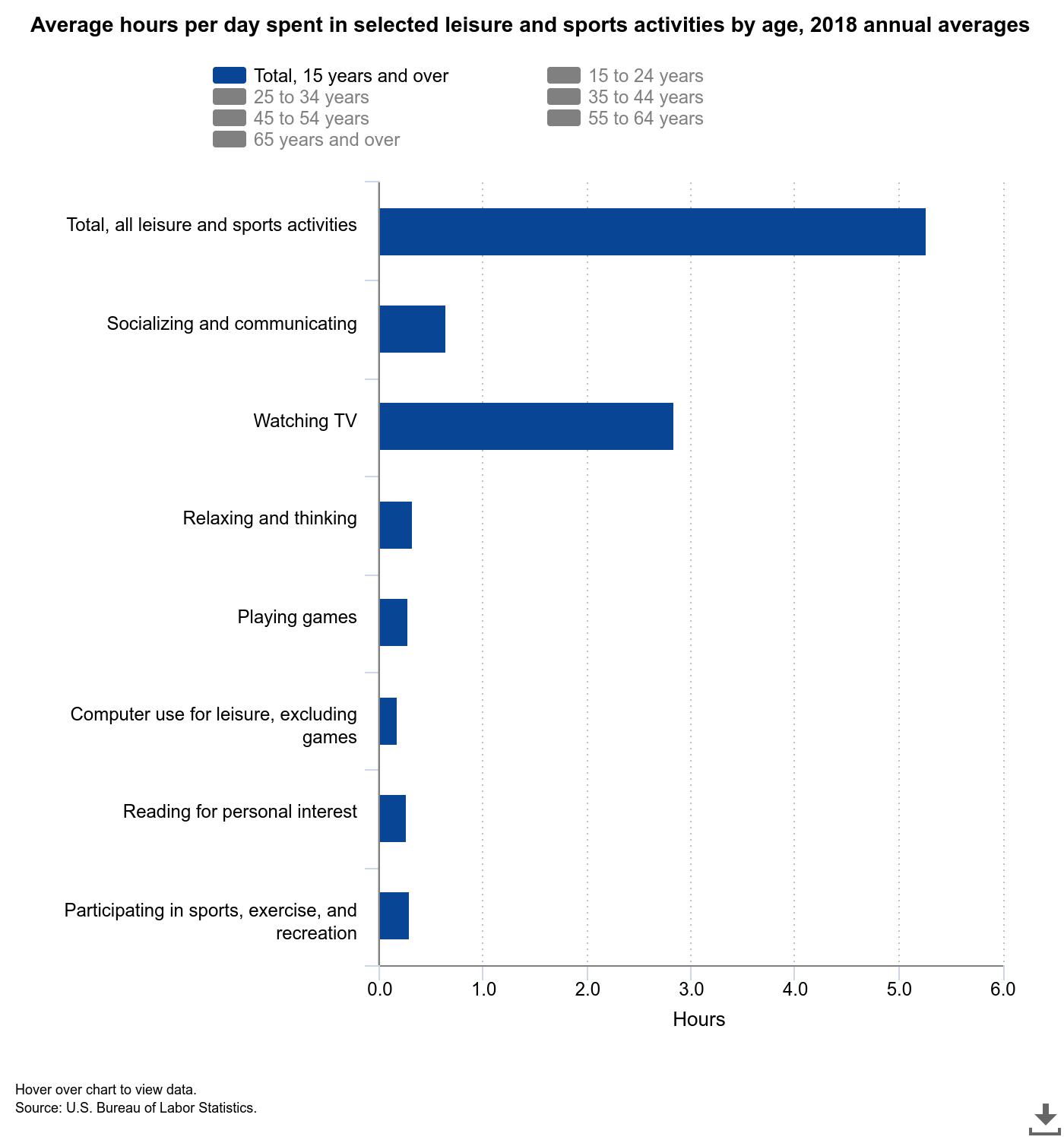
So what’s the demographic upshot of this? The main competitor to engagement of amateur radio operators to being on the air or at their workbench or (name your favorite ham activity) is…Television! This is not shocking to those social scientists who study time use. The Brookings Institution published a study on this using the Time Use Survey covering 2005-2015. They document how “free time became screen time” in the following trend chart, expressed as hours per week instead of day. About 2007, screen time (not just TV) surpassed other active leisure activities in average time spent. By 2015, the gap favoring screen time was over an hour, reflecting over 11 hours per week—on average with some much more and much less—of activity. Sound familiar in your household?

The demographic picture presented here continues to illuminate our understanding of the dynamics of what is a social behavior—amateur radio operation. But there is a demonstrable demographic partition in the time use data, fostered by the social roles and responsibilities typically embedded in U.S. households. Gender, employment, and weekday vs. weekend days interact in sociologically predictable ways as shown in this chart, again from the TUS in daily averages.
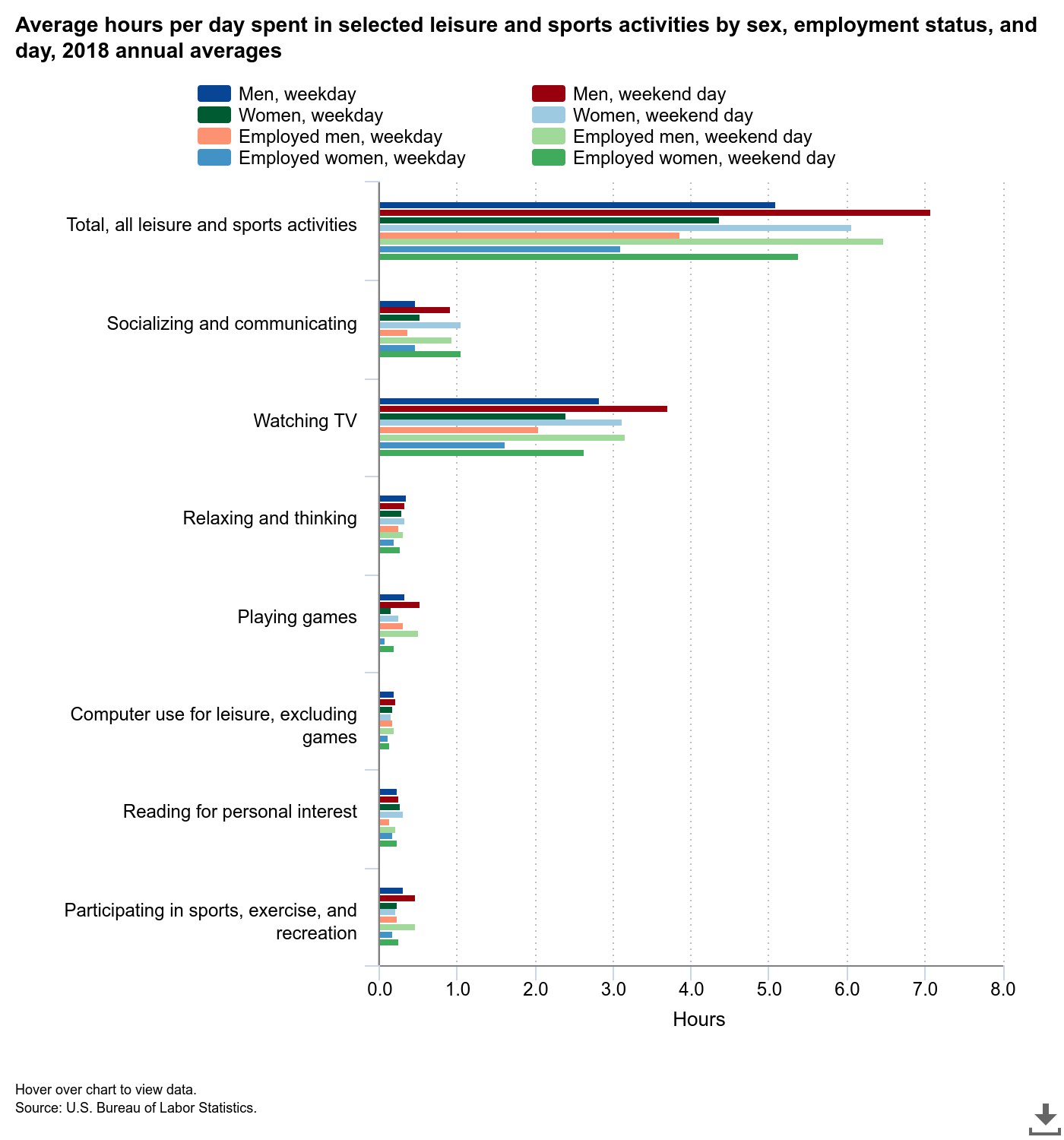
The clearest differential among men and women is in TV watching and socializing/communicating. Whether it’s the weekday or weekend, men systematically spend more time watching TV than women who tend to communicate and socialize more than similar men. Hmm. Women tend to spend more time communicating. Isn’t that promising for amateur radio?
Lemmings and the Demographic Cliff
Tradition and change are terrible bedfellows
One can simply ask after seeing these data: So what? But here’s the deal. Traditional radio sport is facing a demographic cliff of aging ham contesters. Those highly invested in the status quo won’t be around (by becoming SKs) to experience the diminishing participants. They now have the political clout to direct strategic actions. Is this demographic cliff inevitable? It reminds me of the famous IBM-focused Macintosh announcement in 1984, followed up by the Lemmings video in Apple’s 1985 Super Bowl commercial to announce the Macintosh!
I don’t think so, as I stated in the NCJ article series. There are two clear actions that leading organizations can take, which do not suggest that other existing programs should be curtailed or stopped. But is there the political will among decision-makers to take such actions by stepping out of line among the Lemmings?
The ability to make group decisions that often fly in the face of individual power brokers’ individual interests is called social capital. Whether those actors who drive the organization and practice of amateur radio contesting are willing to share resources (e.g., allow newcomers into the circle) and identify as contesting new forms of such competition is how social capital would be manifested in amateur radio. Trust and reciprocity in the common good is the key element for this example.
Social capital, however, is more than simply having social connections and networks. Social capital is exhibited in individuals who have a well-developed sense of mutual trust and “give-and-take” or “reciprocity” in their social networks. Moreover, it is exhibited in individuals who are actively engaged in civic and political life. This trust, reciprocity, and civic and political engagement then enriches the communities where these individuals reside.”
One programmatic change is to actively invite change in the types of amateur radio contests so as to engage a wider variety of hams into contesting activities. This will upset the apple cart of the extant contest culture who currently are invested in the existing models of contesting. Sometimes, hundreds of thousands of dollars are invested. Competition over band frequencies and calendar space is legion as any reading of website such as eHam.net, QRZ.com, and others will reveal. Try launching a new contest for even more direct evidence! But strategic conflict is a necessary evil for social change in many, many cases. No group owns a frequency or calendar dates. We must share them—through active cooperative efforts. But it is also very clear that “tradition” begets a sense of ownership which is anathema to vibrant change for the greater good. Many of the power brokers in the contesting niche in amateur radio here in the U.S. are also significant donors to the ARRL. Some are seated on the Board of Directors. That adds to the ability to have sway over official efforts to move their cheese. Will enough members of that conventional contesting group be willing to change for the good of that part of the hobby? Perhaps not. Nonetheless, I’m optimistic in that the famous Lemmings commercial did have one member of the landed gentry who stopped short of the cliff’s edge to take off his blinders and see the future!
A second is to fish where the fish are and with the most effective bait, recognizing the demographics that shape the potential for recruitment. The ARRL and many local clubs have focused on getting amateur radio into schools. Like the screwdriver antenna example, if you can get the owner(s) to agree to mounting that antenna, it will work. It just won’t work as efficiently as some others. But it does work. I noted in the TUS results above that women spend more time socializing and communicating per week than do men, whether either are employed or whether it’s a weekday or weekend. While it’s not a large distinction, it bodes well for amateur radio educational outreach programs to fish where the fish are. Where are women (and youth)? I’ve written previously that the local public library is strategic.
The average 10.5 trips to the library U.S. adults report taking in 2019 exceeds their participation in eight other common leisure activities.…it’s the most common cultural activity Americans engage in, by far. [emphasis mine]Gallup Survey Organization
Don’t stop working schools for recruitment, if you can get into the increasingly burdened school day and night, but add public libraries as a new “served agency” for educational outreach. The Plant the Seed, Sow the Future initiative launched in the Delta Division by Director David Norris K5UZ is a model for doing so. Some other clubs around the U.S. have begun to practice that model already. Get radio sport as one strategic element to convey amateur radio to young people and women at public libraries. The Covid-19 pandemic, however, has short-circuited most libraries in the short run in terms of physical walk-in programs. But this model clearly has legs for the future, if the ARRL’s other Divisions and the League office itself view the data objectively and be willing to adopt something “not invented here” in Newington.
It is often attributed to the social thinker August Comte to have said, Demography is Destiny. But it does not have to be so. (see my talk to the Sutton & Cheam Society in London) It does require taking the blinders off of tradition and evaluate it for what it is today and what it means for the future. This almost always requires those in power to make such decisions to forsake their own vested interests in favor of change. Like the famous Lemmings advertisement by Apple, not everyone has to walk off this demographic cliff. We just have to take the blinders of tradition off our eyes, wake up, act for the common good, and smell the demographic coffee. Because it’s brewing…
 Armbian Linux for Arm processors and Android TV Boxes.
Armbian Linux for Arm processors and Android TV Boxes.
 A Different Approach to a New Year: the Ham Systems Think!
A Different Approach to a New Year: the Ham Systems Think!
What is the most important aspect of life? Having fun! (Of course!).
Perhaps it is unusual to wax philosophical in an amateur radio forum, but I am going out on a limb to share a perspective that hopefully is refreshingly new and full of life: Systems thinking — an amateur radio approach.
What I’m sharing herein, I find very intense, invigorating, challenging, and motivational! The more I think about amateur radio with this perspective–the Systems Thinking perspective–the more fun I’m able to define, and then accomplish.
In my opinion, this approach to life is REVOLUTIONARY! Why isn’t this knowledge distributed far and wide? Why aren’t these precepts taught in the schools for young children, so that they can be equipped for a life full of accomplished purpose? Perhaps it is due to the deceptive simplicity of approaching life with the perspective of Systems Thinking.
SYSTEMS THINKING AND AMATEUR RADIO
What is Systems Thinking?
In a very simplistic sense, a system is any group of parts that make up one complex whole. Each part cannot function as the whole, and each part interacts with other parts, such that this behavior affects that end result which is expressed by the whole.
Think about a motorcycle. Let’s play with that thought: I disassemble my motorbike in your living room. Once the bike completely taken apart and the parts are scattered all over your living room floor, can any one of those parts support my riding it out to the countryside, and back again? No. Only the bike can act, when it is made whole again, as a motorbike. But, even if the individual parts, doing their part well, try to be the bike all by themselves, but fail, in the end realize that the parts are very important. Each part has a place and a job. Each part belongs.
By now, as you think about this, you probably realize that there is a difference between collections, and systems, of course. A bag of rocks is not a system. A motorcycle is a system. A bag of motorbike parts is not a motorbike. The assembly of the motorbike parts does make a motorcycle.
What does this have to do with amateur radio?
The amateur radio service (hobby) is a system, not a collection. There are many parts–and one of the most important component of the amateur radio system is you and me. We interact with each other, exchanging knowledge, reports, friendships; we each function, lending our functioning the the autonomous self, the amateur radio service.
It takes more than one of us to make up the amateur radio service. It would take at least two amateur radio operators, at the most extreme emaciated existence as a public service. It is obvious that one ham, all by herself, does not make the amateur radio service. No one of us is the amateur radio service, by ourselves. We need each other in order to have a ham radio community–the amateur radio service. Ourselves, our radios, antennas, computers, knowledge, schedules, and so on, are all parts of the big system with which we participate in our community.
Let that sink in.
Ponder the long-term repercussions of this revelation: We need each other, and we need our resources (time, skills, knowledge, radios, etc.).
How do we shape our System? What will elevate our System so that it is effective? And, so we begin to do this, SYSTEMS THINKING.
Please read, and ponder these thoughts, as you read through this article:
https://thesystemsthinker.com/a-lifetime-of-systems-thinking/
Additionally, you should check out this video–it is great!
[embedyt] https://www.youtube.com/watch?v=EbLh7rZ3rhU[/embedyt]
Bonus (not necessary but still VERY good deeper dive):
[embedyt] https://www.youtube.com/watch?v=yGN5DBpW93g[/embedyt]
In my estimation, Dr. Russell Ackoff is amazingly wise, and inspiring!
SYSTEMS THINKING
At the moment, I am studying and trying to implement system thinking. It is the topic I am mostly studying right now.
The following is an introduction to Systems Thinking:
https://thesystemsthinker.com/
Download this useful paper that helps you understand system thinking:
http://nw7us.us/systems-thinking/Introduction-to-Systems-Thinking-IMS013Epk.pdf
I would very much like to hear your thoughts on all of this. Seriously. Take your time. But, let’s start wading through this pool of refreshing water…
Happy New Year!
Tomas Hood
NW7US
Addendum: I do not necessary agree with every perspective, conclusion, or point made by Dr. Russell Ackoff. Never-the-less, the overarching idea of systems thinking seems valid, and is worth considering.





















